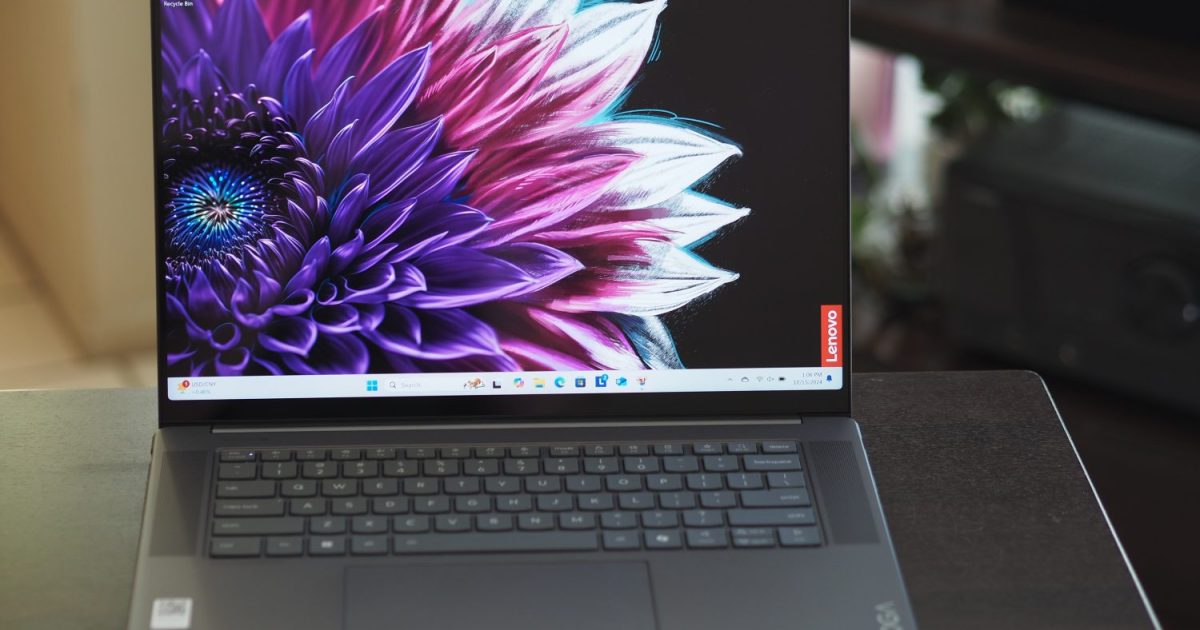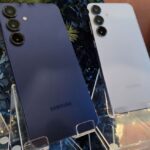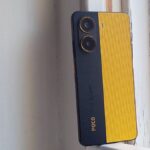There aren’t many options in the 15-inch laptop category, which has given way to slightly smaller 14-inch laptops and larger 16-inch machines. But the MacBook Air 15 stands out as one of the best options you can buy today, as long as you don’t need Windows.
The Lenovo Yoga Slim 7i Aura Edition is a new alternative that runs Intel’s latest Lunar Lake chipsets that are aimed primarily at efficiency — aimed most directly at Apple’s efficient M3 chipset. Can the Yoga Slim 7i compete? Perhaps before this week. But now that the MacBook Air 15-inch starts with 16GB of RAM, the Yoga Slim 7i’s advantages are lessened.
Specs and configurations
| Lenovo Yoga Slim 7i Aura Edition | Apple MacBook Air 15 | |
| Dimensions | 13.54 x 9.27 x 0.55 inches | 13.40 inches x 9.35 inches x 0.45 inches |
| Weight | 3.37 pounds | 3.3 pounds |
| Processor | Intel Core Ultra 7 256V Intel Core Ultra 7 258V |
Apple M3 (8 cores) |
| Graphics | Intel Arc 130V Intel Arc 140V |
10-core GPU |
| RAM | 16GB 32GB |
16GB 24GB |
| Display | 15.3-inch 16:10 2.8K (2880 x 1800) IPS, 120Hz | 15.3-inch 16:10 Liquid Retina IPS (2880 x 1864), 60Hz |
| Storage | 512TB SSD 1TB SSD |
256GB SSD 512GB SSD 1TB SSD 2TB SSD |
| Touch | Yes | No |
| Ports | 2 x USB-C with Thunderbolt 4 1 x USB-A 3.2 Gen 2 1 x HDMI 2.1 1 x 3.5mm headphone jack |
2 x USB-C with Thunderbolt 4 1 x 3.5mm audio jack |
| Wireless | Wi-Fi 7 and Bluetooth 5.4 | Wi-Fi 6E and Bluetooth 5.3 |
| Webcam | 1080p with infrared camera for Windows 11 Hello | 1080p |
| Operating system | 70 watt-hour | MacOS Monterey |
| Battery | Windows 11 | 66.5 watt-hour |
| Price | $1,280+ | $1,299+ |
The Yoga Slim 7i Aura Edition starts at $1,280 for an Intel Core Ultra 7 256V chipset, 16GB of RAM, a 512GB SSD, and a 15.3-inch 2.8K IPS display (the only option). You can upgrade the SSD to 1TB for $42, and at the high end with a Core Ultra 7 258V and 32GB of RAM, the laptop costs $1,422.
The MacBook Air 15 starts out at a similar price, $1,299, for an 8-core CPU/10-core GPU M3 chipset and 256GB SSD. And thanks to the recent change, it now starts with 16GB of RAM for the same $1,299 price. All models come with the same 15.3-inch 2880 x 1864 IPS display. Upgrading to 512GB SSD boosts the price to $1,499, and the maximum configuration with 24GB of RAM and a 2TB SSD is $2,299.
The two laptops are priced closely on the low end; Apple’s exorbitant prices for extra storage makes the Yoga Slim 7i much more affordable.
Design

The MacBook Air 15 uses Apple’s latest design concepts, and in fact other than sheer size it’s hard to tell various MacBooks apart. There’s the same simple, blocky design with curved edges and, in the case of the 13-inch and 15-inch MacBook Air, extreme thinness. There are four colors available, including Midnight, Starlight, Space Gray, and Silver, and it’s an elegant machine. The Yoga Slim 7i Aura Edition is no slouch itself. It comes in just one dark gray color way and maintains Lenovo’s latest design with a modern and minimalist aesthetic. The most noticeable feature is the reverse notch at the top that houses the webcam, which is an opposite approach to Apple’s more controversial display notch.
Both laptops are built extremely well, with all-aluminum manufacture that gives them a robust feel. Both have bottom chassis and keyboard decks that resist bending, but the MacBook Air 15 actually has more flex in its display than the Yoga Slim 7i. Both have hinges that allow the lid to be opened with one hand.
The MacBook Air 15’s Magic Keyboard is arguably more comfortable than the Yoga Slim 7i’s keyboard for long writing sessions. Apple’s switches are fantastic, easily the lightest and snappiest around, and keycap size and key spacing are perfect. The Lenovo keyboard has sculpted keycaps and plenty of key spacing, but the switches provide a little less feedback. A bigger difference is found in the touchpads, where the MacBook Air 15 has the nearly perfect Force Touch haptic touchpad with Force Click functionality, compared to the just-OK mechanical touchpad on the Yoga Slim 7i. The Lenovo laptop does have a touch-enabled display, however, if that matters to you.
Connectivity strongly favors the Yoga Slim 7i, which has a selection of both modern Thunderbolt 4 ports and legacy ports. The MacBook Air 15 has just two Thunderbolt 4 ports, although it leaves both free with Apple’s MagSafe 3 connector. The Lenovo also has the most up-to-date wireless connectivity.
Finally, both laptops have 1080p webcams, while the Yoga Slim 7i supports Microsoft’s Copilot+ PC AI initiative with a fast neural processing unit (NPU) for on-device AI processing. The MacBook Air 15 will support Apple Intelligence as it rolls out.
Performance

The Yoga Slim 7i is built around an Intel Lunar Lake chipset, otherwise known as Core Ultra 2. We reviewed the laptop with the Core Ultra 7 258V, the second-fastest version, a 17-watt 8-core/8-thread chipset that’s the most direct replacement for the 15-watt U-series Meteor Lake chipset. It’s aimed at efficiency over performance, and we can see that when compared to the MacBook Air 15’s M3 chipset. I’m using the 13-inch model as a proxy, because we haven’t reviewed the larger machine with the M3, but if anything its results would be faster. In this case, it’s the 8-core CPU/10-core GPU version of M3.
As we can see, the MacBook Air 15 is faster than the Yoga Slim 7i, especially in multi-task processes. And its GPU is faster than the Intel Arc 140V integrated graphics. They’re both fast enough for demanding productivity users, but the MacBook Air 15 will be faster for creators.
| Geekbench 6 (single/multi) |
Cinebench 2024 (single/multi) |
3DMark Wild Life Extreme |
|
| Lenovo Yoga Slim 7i (Core Ultra 7 258V) |
2,485 / 10569 | 118 / 576 | 5,527 |
| Apple MacBook Air M3 (M3 8/10) |
3,102 / 12,078 | 141 / 601 | 8,098 |
Display

Both laptops use IPS displays, and they’re remarkably close in quality. They both have tons of brightness, both have accurate colors and very good contrast, and the MacBook Air 15’s panel has wider colors. It will please creators.
And, both display are 15.3 inches with roughly equal sharpness. The Lenovo display runs at 120Hz, which will provide for a smoother UI than Apple’s 60Hz refresh rate.
| Lenovo Yoga Slim 7i (IPS) |
Apple MacBook Air M3 (IPS) |
|
| Brightness (nits) |
532 | 495 |
| AdobeRGB gamut | 74% | 87% |
| sRGB gamut | 99% | 100% |
| DCI-P3 gamut | 74% | 99% |
| Accuracy (DeltaE, lower is better) |
0.93 | 1.24 |
| Contrast ratio | 1,470:1 | 1,480:1 |
Portability

Both laptops are very portable laptops with large, 15-inch displays. The MacBook Air 15 is insanely thin at 0.45 inches, but the Yoga Slim 7i is also pretty thin at just 0.55 inches. They weigh about the same, so that gives the MacBook Air 15 a denser feel.
In terms of battery life, I again used the 13-inch as a proxy but the 15-inch MacBook Air M3 will likely get slightly better battery life. And it maintains its place at the top in terms of efficiency. The Intel Lunar Lake chipset is the most efficient yet in a Windows laptop, and the Yoga Slim 7i does very well. But the MacBook Air 15 is stronger in spite of also being faster.
| Web | Video | Cinebench R24 |
|
| Lenovo Yoga Slim 7i (Core Ultra 7 258V) |
14 hours, 16 minutes | 17 hours, 31 minutes | 2 hour, 15 minutes |
| Apple MacBook Air M3 (M3 8/10) |
19 hours, 38 minutes | 19 hours, 39 minutes | 3 hour, 27 minutes |
The Yoga Slim 7i gives it a go, but the MacBook Air comes out on top
There’s a lot to like about the Yoga Slim 7i. It’s built well, looks great, is fast enough, and it gets better battery life than most Windows laptops to date. And it’s a reasonably affordable option.
But, the MacBook Air 15 is still faster, and it gets even better battery life. Its keyboard and touchpad are better, and it, too, is solid and attractive. It’s a hard laptop to beat out, especially now that it starts with 16GB of RAM.
Read the full article here














